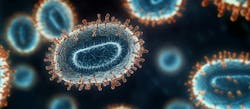Antibodies fighting original SARS-CoV-2 virus weaker against omicron
Research findings were posted online, in the Journal of Clinical Investigation Insights.
“Previous research has shown vaccine-induced antibodies respond to the original strain of SARS-CoV-2 by inhibiting the virus’s ability to bind to angiotensin-converting enzyme 2 [commonly known as ACE2], the receptor on a cell’s surface through which SARS-CoV-2 gains entry,” says study senior author Joel Blankson, MD, PhD, Professor of Medicine at the Johns Hopkins University School of Medicine. “Our study suggests those same antibodies yield less ACE2 inhibition with the omicron strain, opening the door to a breakthrough COVID-19 infection.”
To conduct their study, Blankson and his colleagues analyzed both the humoral (SARS-CoV-2 specific antibodies circulating in the bloodstream and produced by B lymphocytes, or B cells) and cellular (direct attack on the virus by T lymphocytes, or T cells) immune responses in 18 healthy and fully vaccinated people, ages 23 to 62 (mean age of 30), who experienced breakthrough infections within 14 to 92 days (median of 50 days) after receiving a booster COVID-19 vaccine. Fourteen participants received a booster of the Pfizer-BioNTech messenger RNA (mRNA) vaccine, one was boosted with the Moderna mRNA vaccine, and the remaining three had an mRNA booster following their initial dose of the Johnson & Johnson viral vector vaccine.
The humoral and cellular immune responses of those participants with breakthrough infections were compared with those from a control group of 31 participants, ages 21 to 60, who received similar COVID-19 vaccinations and boosters, and had no prior infection with SARS-CoV-2.
Although the researchers were not able to document that the breakthrough infections were from the omicron strain, they say it’s a strong probability because the omicron variant accounted for more than 90% of the COVID-19 cases treated at The Johns Hopkins Hospital (where the study was conducted) during the time when the study participants became symptomatic.
“When we tested antibody-mediated inhibition of SARS-CoV-2 spike protein binding to ACE2, we found that serum from study participants with breakthrough COVID-19 — most likely the result of omicron infection — had antibodies that strongly stopped binding by the original strain virus as expected but didn’t carry out that function as well when responding to the omicron strain,” says Blankson.
The levels of antibodies that inhibited spike protein binding to ACE2 — high for original strain virus but reduced for omicron — were similar for both the participants with breakthrough infections and those in the control group.
The specific reduction in ACE2-inhibiting antibodies responding to omicron, Blankson says, differs from what was seen in previously studied breakthrough infections with the alpha variant. In those cases, infected individuals were found to have lower overall antibody levels to the original virus strain.
This was shown in a second recent study, also co-authored by Blankson, looking at the blood plasma of 15 mRNA vaccine recipients.
“The comparable strong T cell responses for the original and omicron strains in both studies could explain why people, like our study participants, who have breakthrough COVID-19 cases typically experience only mild symptoms during the course of their illness,” he explained.
Mothers with postpartum depression benefit from screening
Cedars-Sinai researchers identified comprehensive nurse training as key to successful hospital screening for mood disorders after childbirth. Nurse education is the key to successfully screening women for postpartum depression, which affects some 15% of mothers, according to a new quality improvement (QI) study from Cedars-Sinai.
“Training that helped nurses get comfortable with the topic of depression and to develop a non-judgmental attitude and openness to a patient’s questions and concerns is critical,” said Eynav Accortt, PhD, principal investigator of the QI review and Director of the Reproductive Psychology Program at Cedars-Sinai.
Depression and anxiety during pregnancy or in the first 12 months after delivery is one of the most common perinatal medical complications. Postpartum depression that sets in after childbirth is often characterized by persistent sadness, fatigue, feelings of hopelessness and worthlessness and trouble sleeping or eating. Some women find it hard to care for their new baby.
Hospitals have been urged to institute postpartum depression screening and referral programs to identify and help women struggling with their mental health. Effective programs and procedures for screening can be challenging to develop. A new quality improvement (QI) initiative by Cedars-Sinai investigators in the Department of Obstetrics and Gynecology identified nurse training and education as key to successfully screening women in their care.
“Our research also revealed that framing the screening as part of the medical center’s commitment to family wellness, as opposed to only using the term ‘depression,’ was helpful. It allowed us to normalize the challenging transition to parenthood these patients often experience,” said Accortt, a Clinical Psychologist and Assistant Professor in the Department of Obstetrics and Gynecology.
The initiative, Implementing an Inpatient Postpartum Depression Screening, Education, and Referral Program: A Quality Improvement Initiative, is published in the American Journal of Obstetrics & Gynecology–Maternal-Fetal Medicine.
Nurses are often on the frontlines of screening programs for postpartum depression, but nursing schools rarely require training in mental health screening or education. Reviewing data involving over 19,500 women who gave birth at Cedars-Sinai allowed investigators to evaluate the benefits of additional training for the nurses charged with accessing new mothers for depression.
“We recognized that we needed to do a better job identifying patients at risk before they went home from the hospital,” said Sarah Kilpatrick, MD, PhD, senior author of the QI study, and the Helping Hand of Los Angeles Chair in Obstetrics and Gynecology at Cedars-Sinai.
“We learned that it is a complicated process requiring dedicated collaboration between nurses, physicians, and information technology personnel to make the system work. Our framework should be reproducible in other hospitals, thus helping even more families recognize and better manage postpartum depression,” said Sarah Kilpatrick, MD, PhD, chair of Cedars-Sinai’s Department of Obstetrics and Gynecology.
An important tool for evaluating a patient for postpartum depression is a special questionnaire designed to identify the presence and seriousness of a mood disorder. Because many nurses called on to administer the questionnaire within two days of a patient giving birth had concerns about doing it correctly, an important quality improvement measure was in-service training; nurses observed a clinical psychologist demonstrate the process with a staff member playing the role of the patient.
If the results of a new mother’s questionnaire suggest she needs help before she leaves the hospital, a visit with a social worker can be scheduled.
“The social worker begins by being a caring, nonjudgmental, listening ear and provides support and resources based on the patient’s needs. She might consult psychiatry if the woman seems unstable and in need of a full psychiatric evaluation. Otherwise, she might provide a referral to our Reproductive Psychology Program or to our patient navigator, who can help connect her to care in the community,” said Accortt.
The postpartum depression screening program at Cedars-Sinai has expanded to include outpatient follow-up. A screening initiative for women who have experienced a stillbirth or who are in the obstetrics intensive care unit has also been implemented.
“If we care about our patients’ mental health, screening must be made routine, just like we screen pregnant patients for diabetes. It must be done in such a way that patients feel comfortable answering the questions truthfully, and there must be consistent follow-up of patients at risk for postpartum depression once they leave us,” said Kilpatrick.
Asthma, hypoxia, and lung damage
New research from scientists at La Jolla Institute for Immunology (LJI), shows that hypoxia can activate the same group of immune cells that cause inflammation during asthma attacks, according to a news release.
Hypoxia, a lack of oxygen, can have long-term effects. In fact, doctors describe hypoxia as an “initial insult.” As a person gasps for breath, these cells flood the airways with molecules that damage the lungs.
Experiencing hypoxia is a known trigger for developing and worsening lung conditions such as severe asthma, chronic obstructive pulmonary disease (COPD), and fibrosis. To treat and prevent these diseases, researchers need to understand why a lack of oxygen would affect the immune system.
“We show how lack of oxygen can be part of a feedback loop that can contribute to even worse inflammation,” says LJI Professor and Chief Scientific Officer Mitchell Kronenberg, PhD, a member of the LJI Center for Autoimmunity and Inflammation. “This work gives us insight into the causes of fibrosis of the lung and severe asthma.”
Kronenberg and his colleagues worked with a genetically altered mouse model to mimic the signals of hypoxia in the airway’s epithelial cells, which line the paths to the lungs. They discovered that combining the hypoxia signals with inflammatory signals stimulated the “innate,” or rapidly responding immunity, and an immune cell type called an ILC2.
An ILC2’s job is to make signaling molecules (called cytokines) that quickly alert other immune cells to react to a pathogen. Unfortunately, ILC2s sometimes over-react and respond to harmless environmental allergens. In these cases, ILC2s churn out cytokines that drive mucus production and inflammation in the lungs. All this swelling and mucus leads to hypoxia.
As they report in Journal of Experimental Medicine, ILC2s respond to hypoxia as well, adding to the lung damage already caused during an asthma attack.
“That hypoxia may then contribute further to inflammation,” says Kronenberg.
The next step was to figure out exactly how epithelial cells activate ILC2 during hypoxia. LJI Postdoctoral Fellow Jihye Han, PhD, led the work to uncover an unexpected culprit: adrenomedullin (ADM). ADM is known for its role in helping blood vessels dilate, but until now it had no known role in immune function.
Kronenberg was surprised to see ADM involved—but not shocked. “We’re finding that many molecules with no previously known role in the immune system can also be important for immune function,” says Kronenberg.
The researchers showed that human lung epithelial cells exposed to hypoxia also produced ADM. This means ADM or its receptor could be targets for treating inflammatory and allergic lung diseases. The challenge is to find a balance between dampening the harmful immune response without leaving the body vulnerable to infections.






